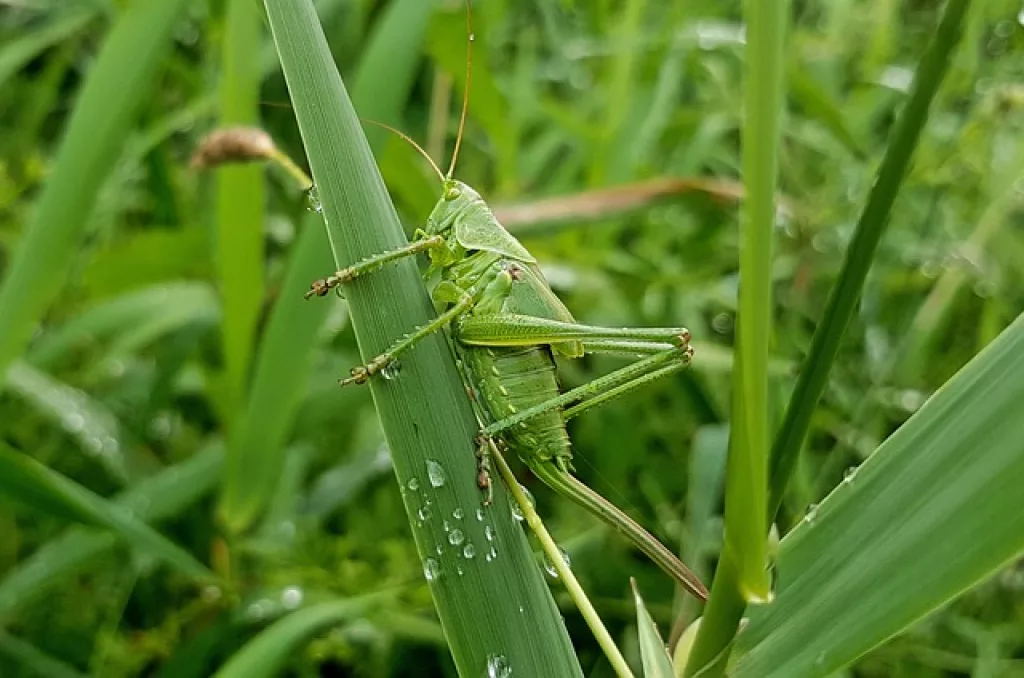The question is do grasshoppers eat grass? Well, most grasshoppers are herbivores, so they feed on plants and nuts, but above all on grass. In this way, your grass can be food for grasshoppers. They may also include pollen and nectar in their diet. However, what grasshoppers eat can vary depending on the species since some can have an omnivorous diet and include insects.
Grasshoppers are elongated insects that live in all parts of the world, but their favorite habitats are forests, crops, and dry land. Although they adapt to practically any environment, they have a preference for warm areas. They are mostly diurnal animals that enjoy the sun, although depending on the temperature they can also be active at night. Their life expectancy is between 2 and 3 months.
Although the grasshopper’s diet is mainly based on grass, they can eat other foods such as flowers, stems, seeds, grains, fruits, and vegetables. You can offer them lettuce, spinach, chard, grated carrots, tomatoes, strawberries, and melons.
These animals have a large appetite and spend most of their time eating. They can consume 16 times their weight. That is why they can become a huge problem when they inhabit crop fields. They are considered one of the worst pests in agriculture since they can destroy entire fields of crops.
There are around 10,000 different species of grasshoppers, but they all share pretty much the same characteristics. The biggest difference between some species and others is their size, which can be from less than 1 cm to 15 cm in length, with females normally being larger than males.
Its color can vary between green, brown, black, yellowish, or with spots, but they are always dull and not very showy tones. Their colors allow them to blend perfectly in nature to hide from their predators.
How do grasshoppers eat?
Grasshopper antennae have taste buds that they use to taste the food before eating it. In this way, they select the one that interests them and discard the one that does not, staying with the one that is fresher and of higher quality. They are quite demanding animals with food. Once this is done, they meticulously crush the food with their jaws, creating a kind of porridge to better digest and swallow it.
Types of grasshoppers
Green grasshopper: Bright green in color and with a brown line that starts on the head and extends to the hind wings. The wings are transparent. The green grasshopper is usually solitary, found mainly among vegetation and moving short distances to feed. To do this, they have powerful jumping hind legs that they can also use to flee from predators quickly if they are threatened.
Giant grasshoppers known as lobsters: They are brown and, although they have wings. They gather in masses capable of traveling long distances in search of food, therefore, they have developed longer and more resistant structures that allow them to migrate, such as wings. Regarding its coloration, some species have adopted these brown tones as a way of adapting to the environment, this is the case for the majority of grasshoppers belonging to the panphagidae family.
Do grasshoppers drink water?
In nature, like other herbivorous insects, grasshoppers obtain the necessary water from their food, such as grass. Being animals that consume vegetables in large quantities, they are always sufficiently hydrated. However, as expected, they will receive a higher water supply if they consume wetter grass or leaves.
Therefore, it is not unusual to see grasshoppers near leaves where the moisture in the air condenses in the form of drops, which can be used by the animal.

Control
When the number of grasshoppers is high and the pest is voracious, they can devour and defoliate entire gardens.
Identification: Grasshoppers come in different sizes, colors, and patterns, often matching green, brown, and yellow.
Common grasshoppers grow from 3/4 to 2 inches (1.90 cm to 5.08 cm) long, but some can be much smaller or much larger. They are often confused with crickets, but grasshoppers have shorter antennae and larger hind legs.
Signs/Damage: Most grasshoppers do not attack specific plants. These insects usually prefer tender, young shoots, but they can feed on all types of plants and all plant parts. Their large mouths do great damage; Instead of chewing on small holes, grasshoppers can consume large sections of leaves, flowers, and vegetables.
Control: Grasshoppers often lay eggs in weedy, poorly attended areas and then migrate to cultivated gardens. Effective treatment focuses on both gardens and their borders. If we want to use chemical methods we must go to our local garden store and receive a local recommendation. This is because chemicals are not similar in every region.
Tip: Keep the garden area and nearby borders free of tall grass and brush where grasshoppers lay their eggs. Plow garden soil in the fall and spring to expose buried eggs for overwintering and reduce future grasshopper populations.

Wrap-Up – Do grasshoppers eat grass
As stated before, grasshoppers eat grass, they are herbivores and like any type of plant. However, they have preferences when comes to their food. If you see a grasshopper in your garden this doesn’t mean that it will devour your lawn. I recommend to keep always an eye and if there is signs of a growing population we should control it.

